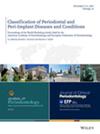硫氰酸盐与牙周炎之间的j形关联:NHANES 2009-2014的横断面研究。
IF 3.8
2区 医学
Q1 DENTISTRY, ORAL SURGERY & MEDICINE
引用次数: 0
摘要
背景本研究旨在评估美国成年人暴露于硫氰酸盐与牙周炎风险之间的关联。方法我们利用 2009-2014 年美国国家健康与营养调查(NHANES)的数据开展了一项横断面研究。我们根据 2017 年的分类方案对牙周炎进行了分类。我们采用了限制性三次样条分析和加权多变量逻辑回归来研究硫氰酸盐暴露与牙周炎之间的关系。我们观察到硫氰酸盐暴露与牙周炎之间的关系呈 "J "形,拐点为 3.32。在拐点之前,我们注意到硫氰酸盐与牙周炎之间的关系呈负相关趋势(几率比 [OR] = 0.89,95% CI:0.73-1.08),尤其是在吸烟者中(OR = 0.31,95% CI:0.08-1.18)。在拐点之后,我们发现两者呈正相关(OR = 1.21,95% CI:1.03-1.42),尤其是非肥胖者(OR = 1.42,95% CI:1.16-1.75)和非高血压者(OR = 1.34,95% CI:1.12-1.61)。结论硫氰酸盐暴露与牙周炎之间存在 J 型关系,表明其作用复杂,需要进一步的前瞻性试验来证实这些发现。本研究试图利用美国国家健康与营养调查(NHANES)的数据,调查硫氰酸盐暴露与牙周炎之间的具体关系。研究结果表明,硫氰酸盐摄入量不足和过量都与牙周炎风险的增加有关,从而强调了维持硫氰酸盐摄入量的最佳范围对牙周健康的重要性。本文章由计算机程序翻译,如有差异,请以英文原文为准。
J-shaped associations between thiocyanate and periodontitis: A cross-sectional study from NHANES 2009-2014.
BACKGROUND
This study aims to assess the associations between exposures to thiocyanate and the risk of periodontitis among US adults.
METHODS
We conducted a cross-sectional study using data from the National Health and Nutrition Examination Survey (NHANES) 2009-2014. We categorized periodontitis according to the 2017 classification scheme. Restricted cubic spline analysis and weighted multivariable logistic regression were employed to examine the relationship between thiocyanate exposure and periodontitis.
RESULTS
A total of 3319 participants were included in our study. We observed a J-shaped association between thiocyanate exposure and periodontitis, with an inflection point at 3.32. Before the inflection point, we noted a negative trend in the relationship between thiocyanate and periodontitis (odds ratio [OR] = 0.89, 95% CI: 0.73-1.08), particularly among smokers (OR = 0.31, 95% CI: 0.08-1.18). After the inflection point, we found a positive association (OR = 1.21, 95% CI: 1.03-1.42), particularly among non-obese individuals (OR = 1.42, 95% CI: 1.16-1.75) and non-hypertensive individuals (OR = 1.34, 95% CI: 1.12-1.61).
CONCLUSION
A J-shaped relationship exists between thiocyanate exposure and periodontitis, indicating its complex role, and further prospective trials are necessary to confirm these findings.
PLAIN LANGUAGE SUMMARY
Thiocyanate, a compound prevalent in both the environment and dietary sources, can impact health through mechanisms that are either protective or detrimental. This study sought to investigate the specific relationship between thiocyanate exposure and periodontitis utilizing data from the National Health and Nutrition Examination Survey (NHANES). The findings reveal that both insufficient and excessive levels of thiocyanate exposure are linked to an increased risk of periodontitis, underscoring the critical importance of maintaining an optimal range of thiocyanate exposure for periodontal health.
求助全文
通过发布文献求助,成功后即可免费获取论文全文。
去求助
来源期刊

Journal of periodontology
医学-牙科与口腔外科
CiteScore
9.10
自引率
7.00%
发文量
290
审稿时长
3-8 weeks
期刊介绍:
The Journal of Periodontology publishes articles relevant to the science and practice of periodontics and related areas.
 求助内容:
求助内容: 应助结果提醒方式:
应助结果提醒方式:


